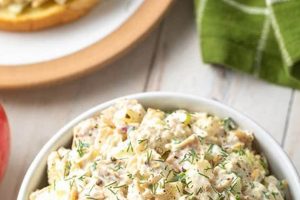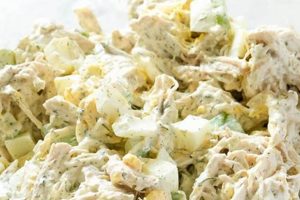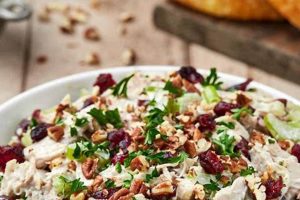A superior chicken salad featuring cranberries typically combines cooked chicken, mayonnaise, and dried cranberries. Variations can include celery, onion, pecans, walnuts, grapes, and seasonings like salt, pepper, and curry powder. A high-quality version often balances sweet and savory flavors, offering a refreshing and texturally diverse culinary experience.
This dish offers a versatile and convenient meal option. It provides a good source of protein from the chicken and offers the potential health benefits of cranberries, known for their antioxidant properties. Chicken salad’s historical evolution reflects changing culinary trends, from simple combinations to more complex and globally-inspired variations. The incorporation of cranberries adds a festive touch, making it suitable for everyday lunches, holiday gatherings, or special occasions.
Further exploration will delve into specific ingredient selections, preparation techniques, and serving suggestions to elevate this classic dish to its full potential.
Tips for an Exceptional Chicken Salad with Cranberries
Elevating chicken salad with cranberries involves careful consideration of ingredients and techniques. The following tips offer guidance for creating a dish that stands out.
Tip 1: Chicken Selection: Opt for high-quality cooked chicken. Roasting a whole chicken or using leftover roasted or poached chicken yields superior flavor compared to pre-cooked or canned options.
Tip 2: Cranberry Preparation: Dried cranberries are readily available, but consider rehydrating them briefly in warm water or juice to plump them and enhance their flavor. Alternatively, fresh cranberries can be finely chopped and added for a brighter, tart flavor.
Tip 3: Mayonnaise Matters: Use good quality mayonnaise. Consider adding a touch of Greek yogurt or sour cream for a lighter, tangier flavor profile.
Tip 4: Balancing Sweet and Savory: Achieve balance by incorporating ingredients like celery for crunch, red onion for a subtle bite, and pecans or walnuts for richness. Seasoning with salt, pepper, and a hint of curry powder adds depth.
Tip 5: Texture Enhancement: Finely dice ingredients for a smoother texture, or leave some ingredients coarsely chopped for a more rustic feel. Consider adding chopped grapes or apples for added sweetness and texture.
Tip 6: Chill Time: Allow the chicken salad to chill for at least 30 minutes before serving. This allows the flavors to meld and the salad to firm up, making it easier to serve.
Tip 7: Creative Serving Suggestions: Chicken salad with cranberries can be served on bread, crackers, croissants, or lettuce cups. It also makes a delightful filling for sandwiches, wraps, or baked potatoes.
By following these tips, one can create a chicken salad with cranberries that offers a harmonious blend of flavors and textures, making it a truly memorable dish.
These techniques offer a foundation for crafting an exceptional chicken salad experience. The following section will explore further variations and serving ideas.
1. High-quality Chicken
The foundation of any exceptional chicken salad rests upon the quality of its primary ingredient: the chicken itself. In the pursuit of the best chicken salad recipe with cranberries, the chicken’s flavor, texture, and overall quality play a crucial role. Selecting and preparing the chicken appropriately significantly impacts the final dish.
- Flavor Enhancement
Chicken contributes significantly to the overall flavor profile of the salad. Freshly roasted or poached chicken offers a depth of flavor often absent in pre-cooked or canned options. The roasting process caramelizes the chicken, adding nuanced savory notes that complement the sweetness of cranberries and other ingredients. This Maillard reaction creates complex flavor compounds, enhancing the overall taste experience.
- Texture Optimization
The texture of the chicken influences the final salad’s consistency. Roasting or poaching results in moist, tender chicken that shreds easily, creating a pleasant mouthfeel. Overcooked or processed chicken, on the other hand, tends to be dry and stringy, detracting from the desired textural balance.
- Ingredient Synergy
High-quality chicken provides a neutral canvas that allows the other ingredients, such as cranberries, nuts, and celery, to shine. Its subtle flavor doesn’t overpower the delicate sweetness of the cranberries or the other complementary components, ensuring a harmonious blend of flavors.
- Overall Culinary Experience
Investing in high-quality chicken demonstrates a commitment to creating a superior culinary experience. It elevates the chicken salad from a simple dish to a more refined and flavorful creation. The difference is readily apparent in the final product, justifying the extra effort in selecting and preparing the chicken.
Ultimately, the choice of chicken directly impacts the success of a cranberry chicken salad recipe. Prioritizing quality in this key ingredient enhances flavor, texture, and the overall culinary experience, contributing significantly to the creation of a truly exceptional dish.
2. Cranberry Preparation
Cranberry preparation significantly influences the final quality of a chicken salad incorporating this tart and vibrant fruit. The method employed affects not only the cranberry’s texture but also its flavor contribution to the overall dish. Several approaches exist, each offering distinct advantages depending on the desired outcome.
Dried cranberries, a common choice, benefit from rehydration. Briefly soaking them in warm water or fruit juice, such as apple or orange juice, plumps the berries, restoring some of their original moisture content. This process also softens their texture, making them more palatable within the salad. Furthermore, rehydration can intensify the cranberry’s natural sweetness and tartness, creating a more pronounced flavor profile that complements the savory elements of the chicken salad.
Alternatively, fresh cranberries offer a different textural and flavor dimension. Finely chopping fresh cranberries allows their bright, tart flavor to permeate the salad. This approach provides a burst of juicy freshness, contrasting with the creaminess of the mayonnaise and the savory notes of the chicken. However, using fresh cranberries requires careful balancing of the other ingredients to avoid an overly tart final product.
Frozen cranberries, while less common, present another option. Thawing and coarsely chopping them allows for integration into the salad. Frozen cranberries retain a similar flavor profile to fresh ones but may release more liquid upon thawing, which should be considered during preparation to maintain the desired salad consistency.
Ultimately, the chosen cranberry preparation method contributes significantly to the overall texture and flavor balance of the chicken salad. Whether plumping dried cranberries, incorporating the bright tartness of fresh berries, or utilizing frozen cranberries, careful consideration of this element ensures a harmonious blend of flavors and textures, resulting in a superior culinary experience.
3. Mayonnaise Choice
Mayonnaise serves as a crucial binding agent and flavor component in chicken salad, directly impacting the final product’s quality. The choice of mayonnaise significantly influences the overall flavor profile, texture, and richness of a cranberry chicken salad. Selecting the appropriate mayonnaise is essential for achieving a balanced and harmonious blend of ingredients.
Standard mayonnaise provides a creamy texture and a tangy flavor that complements the other ingredients. Its richness enhances the mouthfeel of the salad, creating a luxurious and satisfying culinary experience. However, the fat content of standard mayonnaise can sometimes overpower more delicate flavors. In such instances, opting for a lighter mayonnaise, such as one made with olive oil or avocado oil, can offer a healthier alternative without compromising the creamy texture. These options often possess a milder flavor, allowing the nuances of the cranberries and other ingredients to shine through.
Furthermore, flavored mayonnaises, such as lemon-dill or chipotle mayonnaise, can introduce an additional layer of complexity to the salad. These variations can complement the existing flavors or create interesting contrasts, depending on the chosen profile. For instance, a lemon-dill mayonnaise would enhance the brightness of the cranberries, while a chipotle mayonnaise could add a smoky depth. Experimenting with different flavored mayonnaises can elevate the chicken salad beyond the traditional, offering unique and exciting taste experiences. However, caution is advised, as overly strong flavored mayonnaises can mask the subtle sweetness of the cranberries and other delicate ingredients.
In conclusion, the selection of mayonnaise should be a deliberate decision, carefully considering the desired flavor profile and overall balance of the salad. Whether opting for the classic richness of standard mayonnaise, a lighter alternative, or a bolder flavored option, the choice significantly influences the final product. A well-chosen mayonnaise elevates the cranberry chicken salad, transforming it from a simple dish into a culinary masterpiece that balances flavor, texture, and richness.
4. Flavor Balance
Flavor balance represents a crucial element in achieving a superlative cranberry chicken salad. This balance hinges on the harmonious interplay of sweet, savory, tart, and creamy elements. The inherent sweetness of dried cranberries necessitates a counterpoint; this is often achieved through the savory notes of the chicken, the tang of the mayonnaise, and the potential addition of ingredients like diced red onion. Without this careful balancing act, the salad risks becoming overly sweet or one-dimensionally tart. A well-balanced flavor profile ensures complexity and enjoyment, allowing each ingredient to contribute without overpowering the others. For instance, the slight bitterness of pecans or walnuts can offset the sweetness of cranberries, while the fresh crunch of celery adds a contrasting textural element that further enhances the overall experience. The interplay of these flavors creates a dynamic and satisfying culinary experience.
Consider the specific example of balancing sweetness. If the cranberries used are particularly sweet, the mayonnaise choice might lean towards a less sweet, tangier variety. Conversely, if the cranberries are more tart, a touch of honey or maple syrup might be incorporated to subtly enhance the sweetness. Further complexity can be introduced through herbs and spices. A hint of fresh dill can brighten the flavor profile, while a pinch of black pepper adds depth. Even the salt level plays a critical role; insufficient seasoning can render the salad bland, while excessive salt can mask the delicate flavors of the other ingredients. The ultimate objective is to create a symphony of flavors that complement and enhance one another, resulting in a balanced and nuanced taste experience.
Mastering flavor balance elevates cranberry chicken salad from a simple combination of ingredients to a nuanced culinary creation. It transforms the dish from merely palatable to truly exceptional. The careful consideration of each ingredient’s flavor contribution and how it interacts with the others ensures a harmonious and satisfying result. This principle underscores the importance of tasting and adjusting throughout the preparation process, ensuring the final product achieves the desired complexity and balance.
5. Textural Complexity
Textural complexity contributes significantly to a superior cranberry chicken salad experience. It elevates the dish beyond a simple combination of ingredients, engaging multiple senses and enhancing enjoyment. A successful recipe considers the interplay of various textures, creating a dynamic and satisfying mouthfeel. This involves incorporating ingredients that offer contrasting textures, ensuring the salad is neither monotonous nor overwhelming.
- Chicken Texture
The chicken’s texture provides the foundation upon which other textural elements build. Ideally, the chicken should be tender and moist, easily shredding into bite-sized pieces. Overcooked, dry chicken detracts from the overall experience. The method of cooking influences the final texture; roasting or poaching typically yields more desirable results than boiling.
- Cranberry Contribution
Cranberries, whether dried or fresh, introduce a chewy or slightly firm texture. Plumping dried cranberries prior to incorporation softens them, while finely chopping fresh cranberries offers a burst of juiciness. This textural contrast against the softer chicken creates a more interesting and engaging mouthfeel.
- Nut Incorporation
Nuts, such as pecans, walnuts, or almonds, introduce a satisfying crunch and contribute to the salad’s overall textural profile. The size of the nut pieces influences the intensity of the crunch; coarsely chopped nuts offer a more pronounced textural contrast than finely chopped ones.
- Vegetable Enhancements
The addition of vegetables like celery or red onion introduces further textural complexity. Celery offers a crisp, refreshing crunch, while finely diced red onion provides a subtle bite. These elements contrast with the softer textures of the chicken and cranberries, creating a multi-dimensional sensory experience.
The interplay of these textural elements significantly impacts the overall enjoyment of cranberry chicken salad. A well-executed recipe balances these components, ensuring a harmonious blend of textures that elevates the dish beyond the ordinary. The resulting complexity engages the palate, offering a more satisfying and memorable culinary experience.
6. Optimal Chilling
Optimal chilling plays a crucial role in developing the flavors and achieving the desired texture of a best chicken salad recipe with cranberries. This process allows the diverse ingredients, each with its unique flavor profile, to meld and harmonize, creating a more cohesive and nuanced final product. Furthermore, chilling firms the salad, making it easier to handle and serve. Understanding the impact of chilling time contributes significantly to crafting an exceptional cranberry chicken salad.
- Flavor Development
Chilling allows the flavors of the various ingredientschicken, cranberries, mayonnaise, nuts, and vegetablesto meld and mature. The initially distinct flavors begin to integrate, creating a more complex and balanced flavor profile. This process is particularly important for chicken salads with bolder ingredients, as it allows the flavors to mellow and harmonize over time.
- Texture Enhancement
Chilling firms the consistency of the chicken salad, improving its handling and serving properties. The chilling process allows the mayonnaise to thicken slightly, binding the ingredients together more effectively. This prevents the salad from becoming watery or spreading excessively when served on bread or crackers, contributing to a more pleasant eating experience.
- Food Safety Considerations
Chilling is essential for food safety, particularly with mayonnaise-based salads. Maintaining a low temperature inhibits the growth of harmful bacteria, ensuring the salad remains safe for consumption. Adhering to recommended chilling times minimizes food safety risks.
- Serving Temperature and Palatability
A chilled chicken salad offers a more refreshing and palatable experience, particularly in warmer weather. The cool temperature enhances the perception of flavors and textures, making the salad more enjoyable to consume. Serving the salad at the optimal temperature enhances its overall appeal.
Therefore, optimal chilling is not merely a final step but an integral part of crafting the best cranberry chicken salad. It enhances flavor development, improves texture, ensures food safety, and increases palatability. By understanding the impact of chilling, one can elevate this classic dish to its full potential, achieving a harmonious blend of flavors and textures that define a truly exceptional chicken salad.
7. Creative Presentation
Presentation elevates cranberry chicken salad from a simple dish to a culinary statement. Thoughtful presentation enhances visual appeal, stimulating appetite and contributing to a more satisfying dining experience. While flavor and texture remain paramount, creative presentation adds another layer of enjoyment, transforming the ordinary into something special. Consideration of serving vessels, plating techniques, and garnishes significantly impacts the overall perception and enjoyment of this versatile dish.
- Serving Vessels
The choice of serving vessel significantly influences the perceived elegance of cranberry chicken salad. Moving beyond basic bowls, consider using hollowed-out bread loaves, scooped-out avocados, or endive leaves for individual portions. These options add visual interest and textural contrast. For larger gatherings, a platter garnished with fresh herbs and edible flowers creates a visually appealing centerpiece. The serving vessel should complement the salad’s colors and textures, enhancing the overall presentation.
- Plating Techniques
Strategic plating techniques can transform a simple scoop of chicken salad into an artful presentation. Instead of merely piling the salad onto a plate, consider using a cookie cutter to create defined shapes or layering it with complementary ingredients. For example, a bed of mixed greens topped with a neatly formed mound of chicken salad and a sprinkle of toasted nuts offers a more refined presentation. Attention to detail, such as the placement of garnishes and the use of contrasting colors, enhances the visual appeal.
- Garnishes
Garnishes provide the finishing touch, adding pops of color, flavor, and texture. Fresh cranberries, sprigs of dill, chopped pecans, or a drizzle of balsamic glaze can elevate the presentation and complement the salad’s existing flavors. The choice of garnish should be deliberate, considering both visual appeal and flavor compatibility. Over-garnishing can detract from the presentation, so a restrained approach is often more effective.
- Contextual Considerations
The presentation should also consider the context of the meal. A casual lunch might call for a simpler presentation, while a more formal occasion warrants greater attention to detail. For example, serving the salad on individual plates with carefully arranged garnishes elevates the dining experience for special occasions. Adapting the presentation to the specific context ensures a cohesive and appropriate aesthetic.
Ultimately, creative presentation enhances the enjoyment of cranberry chicken salad by engaging multiple senses. It transforms a simple dish into a visually appealing and memorable culinary experience. By considering the serving vessel, plating techniques, garnishes, and context, one can elevate this classic salad to a new level of sophistication, demonstrating culinary creativity and attention to detail.
Frequently Asked Questions
This section addresses common inquiries regarding the preparation and enjoyment of cranberry chicken salad, offering practical guidance for achieving optimal results.
Question 1: What type of chicken is best suited for chicken salad?
While various cooked chicken options suffice, roasted or poached chicken yields superior flavor and texture compared to pre-cooked or canned alternatives. The enhanced flavor derived from roasting significantly elevates the final product.
Question 2: Can fresh cranberries be substituted for dried cranberries?
Fresh cranberries provide a brighter, more tart flavor profile and a juicier texture. Adjusting the sweetness of the recipe may be necessary to balance the increased tartness of fresh cranberries.
Question 3: How can the richness of mayonnaise be balanced in chicken salad?
Incorporating Greek yogurt or sour cream offers a lighter alternative to using mayonnaise exclusively. This substitution reduces overall fat content while maintaining a creamy texture.
Question 4: What complementary ingredients enhance cranberry chicken salad?
Ingredients such as celery, red onion, pecans, walnuts, and grapes contribute textural and flavor complexity. These additions create a more balanced and nuanced culinary experience.
Question 5: How long should chicken salad be chilled before serving?
Chilling for at least 30 minutes allows flavors to meld and the salad to firm, enhancing both taste and texture. Longer chilling periods, up to 24 hours, further develop the flavors.
Question 6: What are some creative serving suggestions beyond bread or crackers?
Cranberry chicken salad can be served in lettuce cups, croissants, or as a filling for sandwiches, wraps, or baked potatoes. These alternatives offer diverse presentation and culinary possibilities.
Careful consideration of these frequently asked questions ensures optimal preparation and a more enjoyable cranberry chicken salad experience. Attention to detail, from ingredient selection to presentation, elevates this classic dish.
The following section will explore recipe variations and additional serving suggestions for cranberry chicken salad.
Conclusion
Exploration of optimal cranberry chicken salad preparation reveals the significance of ingredient quality, flavor balance, textural complexity, and thoughtful presentation. High-quality chicken, proper cranberry preparation, judicious mayonnaise selection, and complementary ingredient incorporation contribute to a superior culinary outcome. Optimal chilling enhances flavor development and texture, while creative presentation elevates the dining experience. Careful consideration of these elements distinguishes a truly exceptional cranberry chicken salad.
Culinary experimentation offers opportunities to personalize and refine cranberry chicken salad recipes further. Adapting ingredients and techniques to individual preferences allows for continuous refinement and the discovery of unique flavor profiles. The pursuit of the “best” recipe remains an ongoing exploration, driven by creativity and a commitment to culinary excellence.






